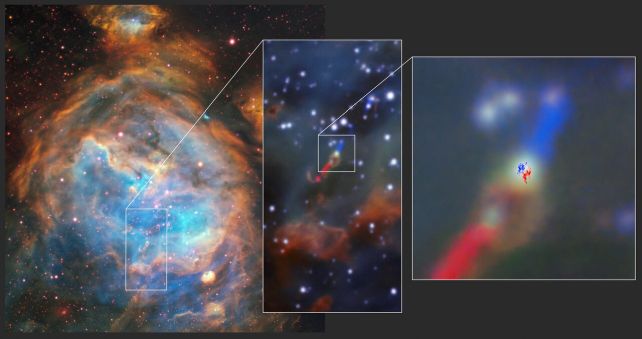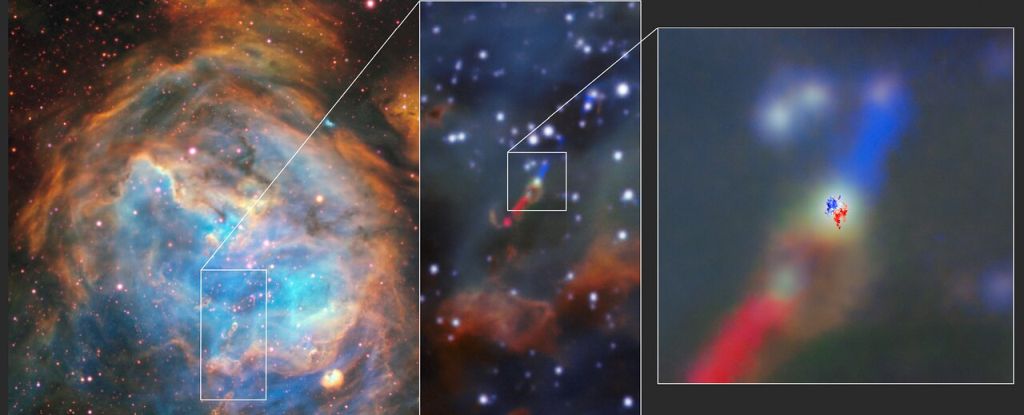Astronomers have recently spotted signs of an extended disk of dust and gas, whirling in orbit around a distant star.
While this phenomenon is a normal stage in the development of a star and its planetary system, what makes this find so spectacular is that it’s the first one we’ve seen around a star in a whole other galaxy, outside of our own.
The feature was spotted in the Large Magellanic Cloud, a dwarf galaxy some 179,000 light-years away from the Milky Way. And, although it might seem like common sense to suppose that star formation processes are universal, we’ve not been able to observe their vagaries outside of our home galaxy before.
“When I first saw evidence for a rotating structure in the ALMA data I could not believe that we had detected the first extragalactic accretion disc, it was a special moment,” said astronomer Anna McLeod of Durham University in the UK, when the findings were published in November.
“We know discs are vital to forming stars and planets in our galaxy, and here, for the first time, we’re seeing direct evidence for this in another galaxy.”
Stars are born from dense clumps in clouds of molecular gas and dust that hang out in interstellar space. When a clump grows dense enough, it collapses under gravity; spinning, it starts to draw in more material from the cloud around it. This material doesn’t just fall onto the protostar any old how, though; it arranges into a disk around the star’s equator, and falls down onto it in a more controlled, steady stream, like water down a drain.
Once the star is done forming, what remains of the disk stays there, clumping together to form all the other elements of a planetary system: the planets, the asteroids and meteors, the comets, the dust. That’s why the Solar System’s planets are more or less orbiting the Sun in a flat plane. We ourselves are like the sentient mold that grew on the leftovers of the Sun’s breakfast.
The Atacama Large Millimeter/submillimeter Array (ALMA), a powerful radio telescope, has imaged quite a few such disks throughout the Milky Way, in various stages of development; some have clear gaps that are thought to be cleared by planets clumping together as they orbit. But the farther away something is, the harder it is to resolve, even with a powerful telescope.

McLeod and her colleagues embarked on their campaign to find an extragalactic stellar disk when data obtained by the Multi Unit Spectroscopic Explorer (MUSE) instrument on the Very Large Telescope revealed signs of a jet, in a system named HH 1177.
These, too, are a signature of star formation: some of the material swirling around the forming star gets whisked away along its magnetic field lines to the poles, where it is launched into space in the form of a powerful jet.
The researchers wanted to see if they could spot the disk in the dusty heart of star formation, so they used ALMA to look for signs of rotation. This can be seen in the way wavelengths of light are shortened as the source is pushed towards us, and lengthened as they are pulled away.
“The frequency of light changes depending on how fast the gas emitting the light is moving towards or away from us,” explained astronomer Jonathan Henshaw of Liverpool John Moores University in the UK. “This is precisely the same phenomenon that occurs when the pitch of an ambulance siren changes as it passes you and the frequency of the sound goes from higher to lower.”
frameborder=”0″ allow=”accelerometer; autoplay; clipboard-write; encrypted-media; gyroscope; picture-in-picture; web-share” referrerpolicy=”strict-origin-when-cross-origin” allowfullscreen>
Interestingly, the ALMA data showed clear signs of this rotation. The star, the team’s analysis revealed, is very young and massive, still feeding from the disk around it. This is pretty normal. But there was a difference between it and the protostellar disks found in the Milky Way: the HH 1177 disk can be seen in optical wavelengths.
This, the researchers explain, has to do with the interstellar environment in the Large Magellanic Cloud. There is much less dust there; so the HH 1177 star is not as shrouded in a curtain of material as young, massive Milky Way stars usually are.
This makes the discovery an important one for studying, not just how stars form in different environments, but the limits those environments can place on star formation in general.
“We are in an era of rapid technological advancement when it comes to astronomical facilities,” McLeod said. “Being able to study how stars form at such incredible distances and in a different galaxy is very exciting.”
The research has been published in Nature.
A version of this article was first published in December 2023.













/https://tf-cmsv2-smithsonianmag-media.s3.amazonaws.com/filer_public/34/31/3431771d-41e2-4f97-aed2-c5f1df5295da/gettyimages-1441066266_web.jpg)



![Ep266: [Lean Series] How to Plan a Responsible Fat Loss Phase Ep266: [Lean Series] How to Plan a Responsible Fat Loss Phase](https://carrotsncake.com/wp-content/uploads/2024/06/Carrots-N-Cake-VIP-Nutrition-Coaching-768x1040.jpeg)
.jpg)

Discussion about this post